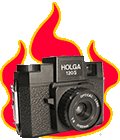Well, until my recent film shooting bug hit me, anyway. I started looking around at old rangefinders, folding 6x6, and other old cameras, thinking it was a way to get what I wanted in a point-and-shoot: quality images, manual control, low low price. So here's what I got:

The Ricoh 35 ZF is a 1970s point-and-shoot camera that takes ASA 25-800 film. It's extremely easy to use and has a 40mm f/2.8 lens. This one came from Collectible Cameras in Phoenix, AZ. Check them out if you're looking for a used camera of any kind. Their selection is amazing, and they're very nice to deal with.

The little lever to the right of the lens is the self-timer.
The "ZF" stands for "zone focus," I think. You focus this thing by guessing the distance from your subject, and the distances are divided into three zones: torso (1 meter), person with legs (2.5 meters), and mountain (infinity). You just twist the dial to one of those settings and fire away. It does have a distance scale with intermediate values, however, so I'll have to test that out as I go.

Like my Canon AE-1, this is a shutter-priority camera. You choose a shutter speed (1/8, 1/15, 1/30, 1/60, 1/125, 1/250, 1/500, or bulb) and its light meter determines the aperture. Manual override is also possible (f/2.8-16). The light meter originally ran on a 1.3v mercury battery, but it works fine on a 675-type hearing aid battery (1.4v — we'll see if that affects metering at all).
It has a viewfinder, but it's just a hole on the side of the camera. The lens is visible when you look through it. A needle shows the chosen aperture if you're in automatic mode.

The manual proudly boasts that this camera is "small enough to carry in your pocket." Maybe if you're wearing a jacket or cargo shorts. It's bigger than the Canon G10, and would be best suited to wearing around your neck. This was definitely a no-nonsense tourist's camera in its day.
So why did I bother dusting off my AE-1 and acquire this old, featureless clunker? It's because I want to force myself to think about photography in different ways from time to time. I still shoot 99% of my photos with my 40D. But every now and then I plan to rip through a roll of film on these two cameras, both of which take away most of the features I take for granted when I use a digital body.
In theory, this should get me thinking more about composition and pay off down the road. We shall see!


Hi Zak,
ReplyDeleteIt's enjoyable to read your retro discoveries. If the goal is making better photos, it's not about any one piece of equipment. Keep posting your productions.